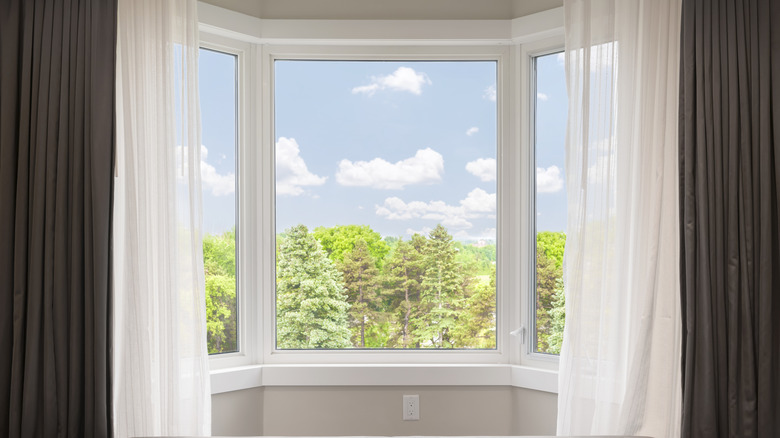Give Bay Windows An Elevated Look With These Layered Combinations
Bay windows are one of the most charming features a home can have, but they deserve thoughtful styling in order to truly shine. Their distinctive style floods rooms with natural light through a multi-window design that pushes outward from the wall, adding a touch of architectural flair inside and out. That said, dressing these unique windows can be a bit more complex than more typical frames.
In many cases, single window treatments may seem insufficient against the large presence of bay windows, making layered combinations the most effective way to elevate their look. One helpful approach is to layer elements of function and flair, like combining Roman shades with full-length curtains. Valance curtains are also a great decorative element, which you can layer over more practical pieces, such as roller or cellular shades.
Another layering strategy for bay windows pairs soft and heavy treatments to create a sense of balance. This could look like sheer curtains under thicker, opaque drapes, or combining plantation shutters with soft, flowing curtains. There are endless ways to decorate a bay window, but layering treatments is the perfect place to start. Bay windows create a natural focal point; by exploring different design combinations, you can express your personality with styles that take center stage.
A mix of function and flair
The large size of bay windows tends to lack insulation and draw in excessive natural light and unwanted attention from the outdoors. While practical treatments are necessary, bay windows are also a major design asset and require stylish treatments to thrive — aim for function and flair.
One of the best layered combinations pairs classic Roman shades with curtains for a charming, functional look. The perfect length for bay window curtains is just at the sill for kitchens and bathrooms and floor-length for living rooms and bedrooms. Consider pairing full-coverage curtains with stationary Roman shades or frame practical shades with narrow, decorative drapery. Essentially, one layer serves as a stylish accent while the other handles all the practical needs. You could mix a patterned shade with a solid curtain and vice versa. Or, use bold and neutral colors for a contrasting effect.
Another great pairing is valance curtains with roller or cellular shades. These shades are perfect for light control, energy efficiency, and flexible privacy. You'll want to keep the shades simple and neutral to let the valance's stylish appeal stand out. Valances frame your bay windows beautifully and bring a sense of sophistication while the shades tackle the essentials. It's best to opt for stylish prints or rich textures in the valances to fulfill the stylistic intent. If you really want them to be the center of attention, you can easily hide your shades underneath.
Layering softness with structure
Pairing soft and heavy elements when dressing your bay windows allows you to create the perfect amount of contrast and dimension. One classic approach that looks great on any window is to pair sheer curtains underneath heavier fabrics, such as velvet, brushed cotton, or blackout drapes. When choosing sheers, it's best to aim for soft hues or patterns that complement your room's decor and color palette.
For the drapery, you can pick a bold and contrasting color. If your want to stick to neutrals, go for a unique texture that contrasts the softness of the sheers. Prioritizing a balance of delicateness and strength will overall help you to successfully layer curtains, making your bay window even more charming.
If you're looking for a more structured approach, combining plantation shutters with soft curtains may seem unexpected but works beautifully alongside the style of bay windows. The crisp lines of shutters in comparison to the softness of curtains creates a dynamic texture. This pairing also works practically to give your windows more privacy and light control.
To perfect the balance of this combination, it's helpful to match the curtain's color to your shutters. If you want something more striking, choose colors that stand out against each other. For example, white curtains against white shutters will create a soft and airy feel, while pairing charcoal gray shutters and light, beige curtains will make a chic statement.

